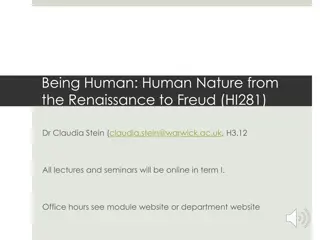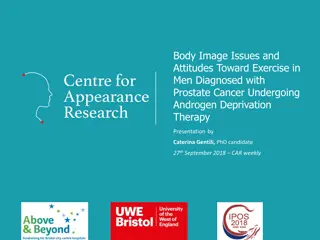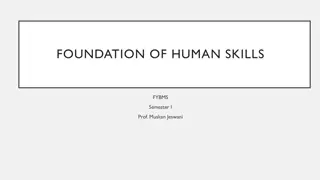Adlerian Therapy: Evolution of Human Nature
Alfred Adler, a key figure in the development of psychodynamic approaches to counseling, emphasized the impact of social and cultural factors on personality development. Departing from Freud's deterministic views, Adler viewed humans as creators of their own lives. The formation of his theories, built on his own life experiences, highlights the importance of overcoming childhood influences and shaping our destinies. Explore the key concepts of Adlerian therapy and the significant role of social and cultural factors in shaping individuals.
Download Presentation

Please find below an Image/Link to download the presentation.
The content on the website is provided AS IS for your information and personal use only. It may not be sold, licensed, or shared on other websites without obtaining consent from the author.If you encounter any issues during the download, it is possible that the publisher has removed the file from their server.
You are allowed to download the files provided on this website for personal or commercial use, subject to the condition that they are used lawfully. All files are the property of their respective owners.
The content on the website is provided AS IS for your information and personal use only. It may not be sold, licensed, or shared on other websites without obtaining consent from the author.
E N D
Presentation Transcript
Adlerian Therapy Dr.A.John Balaiah
ALFRED ADLER Vienna (1870-1937) Third among five boys and 2 girls At 4, almost died of pneumonia Decision to become a doctor He was all ill during the early childhood years Pampered by Mother Later he was dethroned by his younger brother
FORMATION OF THEORY Who shaped his own life Not determined by his fate Fit to be a Shoemaker- Teacher said Started as an ophthalmologist then to General medicine Neurology and psychiatry Incurable childhood diseases Outspoken on childhood reforms, school reforms Love for the common person He served in World war I as medical officer Numerous Child guidance clinics Visited USA Died in Scotland while taking a walk before a lecture
AA Instrumental in the formulation of psychodynamic approaches to counselling Social and cultural factors had great impact on the personality development of a person Moved away from Freud s biological and deterministic view of human nature (Karren Horney, Erich Fromm, Harry Stack Sullivan)
SOCIAL & CULTURAL FACTORS IPL Social Roles, social expectations, Leadership styles Political ideologies Communication patterns Patterns of Economic prosperity Poverty, war or peace Patterns of intolerance Discrimination Family organization Rituals, cultural myths
CHANGE FACTORS Move from one culture to another Entry into new roles Age graded expectations Historical events
AA Social psychological and teleological view of human nature Where we are going is more important than where we have come from (Past- Future) Humans as creators and creations of their own lives ( Self made people) Not determined by childhood experiences We shape our lives rather than shaped by our childhood experiences
KEY CONCEPTS View of human nature Freud was narrow in his stress on biological and instinctual determination Largely influenced by first six years No exploration but he is interested in the person s perception , this interpretation has a continuing influence Humans are motivated by social urges rather than sexual urges Behaviour is purposeful and goal directed Consciousness and not unconsciousness is the centre of personality
ADLER VS FREUD Social Vs Sexual Consciousness VS unconsciousness Past Vs Future Choice Vs Compulsions Responsibility Vs Instincts Subjective Vs objective ( other, object) Growth Model Vs Developmental model Meaning in life Vs Gratification of instincts Therapeutic Relationship (Equal) Vs Neutral
KEY CONCEPTS AA stresses Choice and responsibility Meaning in life and striving for success or perfection Feelings of inferiority can result in neurotic behaviour (BUT) In the right setting it can also be used as motivation to strive for greater success Feelings of inferiority can bring the wellsprings of creativity
KEY CONCEPTS Humans are not determined by heredity and environment Instead they have the capacity to interpret, influence and create events What we were born with is not central rather what we do with the abilities we possess Adlerian recognize that biological and environmental conditions limit our capacity to choose and create Although they disagree with Freud on many counts , they do not say that individuals can become whatever they want
GROWTH MODEL & SUBJECTIVE APPROACH TO PSYCHOLOGY Re-educating and reshaping the society Forerunner of a subjective approach to psychology which focuses on internal determinants of behaviour such as values , beliefs, attitudes, goals , interests and the individual perception of the society Pioneer of an approach that is holistic, social, goal oriented and humanistic Phenomenological it pays attention to the individual way people perceive their world
SUBJECTIVE APPROACH Phenomenological Subjective frame of reference Subjective perception Subjective world view as a basic factor to explain behavior Many contemporary theories have incorporated the subjective reality - How life is in reality is less important than how the individual believes life to be (Existential therapy, Person centered therapy, Gestalt therapy, Cognitive behavior therapies, reality therapy)
UNITY AND PATTERNS OF PERSONALITY Basic premise- Individual psychology Individual is indivisible whole, born, reared , living in specific familial, social and cultural contexts Social, creative , decision making who have a unified purpose and cannot be fully know outside this context
UNITY AND PATTERNS OF PERSONALITY A person becomes unified through the life goal Feelings, thoughts , beliefs, character and actions are expressions of his uniqueness Self selected life goal Client is an integral part of a social system More focus on interpersonal relationships than on the individual s internal dynamics
BEHAVIOUR AS PURPOSEFUL AND GOAL ORIENTED Adler replaced determinism with teleological ( purposeful and goal oriented ) What we are striving for is very crucial ( Individual psychology) Decisions should be based on experiences , on the present situation, and on the direction in which person is moving Pay attention to the themes running through one s life
FICTIONAL FINALISM- Fictional finalism- Imagines central goal that guides the behaviour People live by fictions / views of how the world should be ( Hans Vaihinger s View) The guiding fiction may be expressed as only when I am perfect, can I be secure Only when I am important can I be accepted The fictional goal motivates a person for a particular position Finalism refers to the ultimate nature of the goal , by which we have the creative power to choose what we will accept as truth, how we behave, how we interpret events and how we misbehave.
STRIVING FOR SIGNIFICANCE AND SUPERIORITY Striving for perfection and coping with inferiority by seeking mastery are innate To understand human behaviour it is essential grasp the ideas of basic inferiority and compensation The moment that we feel inferior , we are pulled by the striving for superiority Superiority does not mean being superior to others but rather attaining a perceived better position in life Felt minus to a felt plus Change a weakness into strength Strengthen competencies
SOCIAL INTEREST Most distinctive concept Aware of a part of a human community and to the individual s attitudes in dealing with the social world Socialization process begins in childhood Finding a place in the society Equated social interest with identification and empathy with others To see with the eyes of another, to hear ... To feel Sharing is a measure of mental health As social interest develops , feelings of inferiority and alienation diminish It is taught, leaned and used
SOCIAL INTEREST No social interest, become useless side of life Many of the problems are due to the fear that we are not accepted by the group that we value
MOSAKS FIVE LIFE TASKS Relating to others ( Friendships) Making a contribution (work) Achieving intimacy ( love and family relationships) Getting along with ourselves Developing spiritual dimensions( Values, meanings, life goals, relationship with the universe and cosmos)
BIRTH ORDER POSITION The oldest Centre of attention, Dependable, hard working and strives to keep ahead. With the arrival of a new brother or sister , feels ousted from the favoured position No longer unique Newcomer is an intruder
BIRTH ORDER POSITION The Second child Shares attention with another child . Generally in a race and with full steam. Finds the weak spots of the oldest and strives to get appreciation and praise from the parents and teachers Second one is often opposite to the first born
BIRTH ORDER POSITION Middle child Feels squeezed. Feels cheated on many accounts. Poor me attitude and can become the problem child If there is a family conflict, may become a switchboard and often the peacemaker
BIRTH ORDER POSITION The youngest is always the baby of the family. Most pampered one. They tend to go on their own way Special role to play Creative ways that others have not even thought about it
BIRTH ORDER POSITION The only child Shares the characteristics of the first one ( high achievement drive) May not share or cooperate with others Dependent on either of the parents / both Learn to deal with adults as well Centre stage all the time and if it is challenged, will feel very unfair Certain personality trends have a huge impact in the adult life
THE THERAPEUTIC PROCESS Therapeutic goals Collaborative Relationship on a mutual respect Disclosing mistaken goals and faculty assumptions Holistic psychological investigations/Life Style To assist clients to understand unique life styles To meet the tasks with courage and social interest Not a medical model ( sick need of curing ) In reeducating individuals and in reshaping society Fear and courage go hand in hand ( courage to do) Discouraged people do not act in the social interest
MOSAN AND MANIACCI Goals for the education process of therapy Fostering social interest Helping clients overcome feelings of discouragement Modifying views and goals/ Changing life style Changing faulty motivation Encouraging individuals to recognize equality among people Helping people to become contributing members of the society
THERAPISTS FUNCTION AND ROLE Correct the faulty cognitions ( Beliefs and goals) To make the comprehensive assessment of client s functioning Gathering family constellation (Questionnaire Basic personality) Early recollections as a diagnostic tool (Reflect current convictions, evaluations, attitudes and biases) Identifies major success, failures and mistaken beliefs (Life Style Assessment)
CLIENTS EXPERIENCE Life style Blue print Explore private logic- concepts about self , others and life that constitute the philosophy on which individual's life style is based Problems are due to the conclusions of the private logic that do not conform to the requirements of the society Discover basic mistakes Eg. Depressed man ( No one cares, critical, things will rarely work out, guilt that he is letting everyone down)
CLIENTS EXPEREINCE Private logic I must get what I want in life I must control everything in life I must know everything, otherwise catastrophe I must be perfect in everything I do # Feeling but beleifs >>> emotional and behavioural disturbances Learn better ways of thinking in order to act & Feel better Clients are not sick but discouraged Receive encouragement
RELATIONSHIP BETWEEN THERAPIST AND CLIENT Equals cooperation, mutual trust , confidence and alignment of goals Plan Detail- Contract what they want where are they heading Developing a contract is not a requirement Client is not a passive recipient Collaborative partnerships Without initial trust and rapport, the difficult work of changing one s lifestyle is not likely to occur
APPLICATION: THERAPEUTIC TECHNIQUES & PROCEDURES Four Phases 1. Establishing the Relationship Working relationships Helping clients to become aware of their assets and strengths rather than liabilities and deficits Listening, responding, demonstrating respect, capacity to change, genuine enthuciasm When they enter therapy Diminished sense of worth Support- antidote to despair and discouragement Attending Ph and Psy Listening - VM & NVM
POWERS & GRIFFITH Initial interview What brought to see me? What have you done about your problem now? What would you do if you were well? What are your expectations of our work together?
PHASE TWO Exploring the individual s dynamics Two folds: Understanding life style & how it affects the current task functioning? Counsellors help the clients to connect the past/present and the future Life style: Feelings, beliefs , motives and goals Life style investigator Interpretations of private logic: If they are not perfect, they are a failure Aware of negative thinking and how it restricts their living Psychological explorers in their journey More productive and constructive future
THE FAMILY CONSTELLATION Evaluating the conditions that prevailed in the family when the person was young child in the process of forming lifestyle convictions and basic assumptions in life Lifestyle assessment questionnaire ( Power, Griffith, Mosak and Shulman ) Early Recollections- Before the age of 9 ( at least three) Tell me what moments stand out for You? Remember only those things consistent with the current view of themselves Limitted perception strengths people s private logic
DREAMS Projections of a client s current concerns and indications of his / her mood. Dreams are rehearsals of possible future courses of actions Dreams are purposeful and unique No fixed symbolism in dreams
PRIORITIES Israeil Psychologist , Nera Kefir Four priorities 1.Superiority Leadership & Accomplishment Overwork, overburdened 2.Control Guarantees against ridicule, cannot tolerate humiliation, socially successful 3. Comfort- Avoid pain and stress. Delay the process of decision making. Routine tasks are avoided 4. Pleasing Avoid rejection by seeking constant approval and acceptance Is it therapists role to change one s behaviours? Can we aim for wide range of behaviours to attain significance?
INTEGRATION & SUMMARY Life style q reveals a pattern of basic mistakes, faulty assumptions, absolutes, rigid stands that makes it difficult for a person to enjoy life Read the summary to the client In the following session, the client reads the summary loud Obseve NVM
MOSAKS 5 MISTAKES Life style can be conceived of as a personal mythology as if everything was true 1. Overgeneralizations: No Fairness in the world 2. False / Impossible goals_ I must please everyone, if I am to be loved 3. Misperceptions of life- Life is very difficult for me 4. Denial of one s worth- I am stupid 5. Faulty Values- I must go to the top regardless of who gets wounded ( Ruth s Case) Encouragement process: Asking the clients to challenge the mistakes Discouragement is the basic condition that prevents people from functioning
PHASE 3 Encouraging insight Though they are supportive they are also confrontive * Insight is a step towards behavioural changes Interpretation is a technique that facilitates the process of getting insight it seems to me ...... I have a hunch....This is how it appears to me .... Interpretation is a virtue than a technique
PHASE 4 Helping with reorientations/ Action -insights into practice Re-education Act as if they wanted to be this way not the other ways ( Mistakes) Clients are asked to catch with old patterns and take a pause that will help them to modify their behaviours Consider possible alternatives and commitment to the decisions ( Reorientations)
TECHNIQUES Immediacy: What is going on in the present moment Client is leaning on you for advice from you ... Say it Self defeating by clinging on to the faulty belief that she cannot take decisions
PARADOXICAL INTENTION Way of changing behaviour Prescribing the symptoms and anti-suggestion Outcome: Exaggerate debilitating thoughts and behaviours Symptoms become out of proportion It joins the client s resistance Procrastinations Exaggerations of behaviours can help the client might learn from the experiment Insight- How they are dramatically behaving and the consequences of it
ACTING AS IF Role paying situation Imagine and act the way they like to be Ruth she is not attractive Married the one who dated What would have happened, if you had acted as if..... You were very attractive Positive experiences and positive changes in the plans
SPITTING IN THE CLIENTS SOUP Counsellor determines the purpose and payoff of some behaviour and then spoils the game by reducing the usefulness of the behaviour in front of the client s eyes Eg: Father Vs children Mileage out of the situation Works hard that the children can enjoy Martyr stance The price that he pays May continue with the behaviour but he does not want to deceive himself
CATCHING ONESELF Client becomes aware of some self destructive behaviour / irrational thought but does not engage in self condemnation Initially clients catch themselves too late Follow same patterns Father Vs Children Avoid using guilt as a way to get gratitude Still catch up with the same old patterns Client can take a break and consider other ways of responding
PUSH BUTTON TECHNIQUE Positive Event VS Negative Event Pleasant & Unpleasant Experiences Feelings followed Visualization process Eg. Depression Result of thinking Aim- Clients can create whatever the feelings they desire by deciding on their thoughts Counsellor sends home ( 2 butts- De.. butt and ha... butt)
AVOIDING TRAPS Some of the self defeating patterns ( No one cares) Cling on to pay off Set Up a situation that counsellors may react in the same way others react Not to reinforce behaviours Encourage those behaviours that will bring psychological maturity
TASKS SETTING & COMMITMENT Concrete steps and commitment Tasks must be realistic and achievable Long term goals and direction























